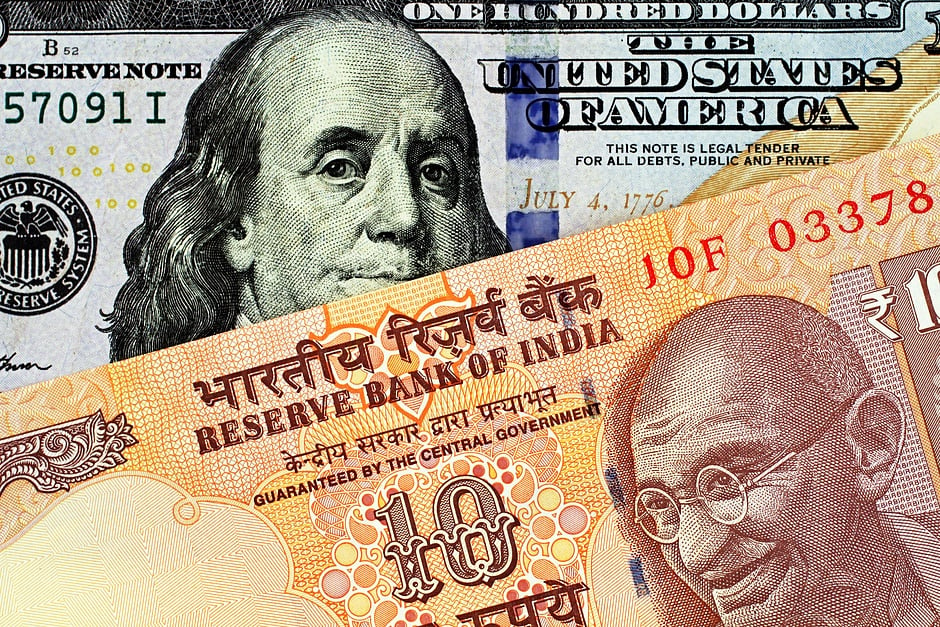USD/INR rises as buoyant US Dollar pressures Indian Rupee
- The Indian Rupee softens in Monday’s early European session.
- A stronger USD and concerns over slowing domestic growth could drag the INR lower, but RBI intervention might cap its downside.
- The US November CPI inflation report will be released on Wednesday ahead of Indian CPI data.

The Indian Rupee (INR) weakens on Monday. The weakness in the Chinese Yuan, the renewed US Dollar (USD) demand from importers and local oil companies, and concerns over slowing domestic growth could weigh on the local currency in the near term. Despite this weakening, the expectations of increased government spending and foreign exchange intervention by the Reserve Bank of India (RBI) might help limit the INR’s losses.
Traders will monitor the US November Consumer Price Index (CPI) report on Wednesday, which is expected to rise to 2.7% YoY in November from 2.6% in October. This reading could be the last major obstacle to the Federal Reserve’s (Fed) third consecutive rate reduction. On the Indian docket, the CPI inflation data will be published on Thursday.
Indian Rupee drifts lower amid firmer US Dollar and slowing India’s economic growth
- The RBI kept its benchmark repo rate unchanged at 6.50% during its October 2024 meeting.
- RBI Governor Das said, “The MPC believes that only with durable price stability can strong foundations be secured for high growth. The MPC remains committed to restoring the inflation growth balance in the overall interest of the economy.”
- India's forex reserves increased by $1.51 billion to $658.091 billion for the week ended November 29, according to the RBI on Friday.
- "We doubt Asian FX can strengthen further from here, especially in H1 2025, given the likelihood that Trump 2.0 will be fast and furious in tariff implementation, making it somewhat attractive to put on some hedges against Asian FX weakness," noted MUFG Bank analysts.
- The US Nonfarm Payrolls (NFP) increased by 227,000 in November, compared with an upwardly revised 36,000 in October, according to the US Bureau of Labor Statistics (BLS) on Friday. This figure came in better than the estimation of 200,000.
- The US Unemployment Rate ticked up to 4.2% in November from the previous reading of 4.1%, in line with the expectations of 4.2%.
- The annual wage inflation, as measured by the change in the Average Hourly Earnings, held steady at 4.0% YoY in November, coming in above the market forecast of 3.9%.
- San Francisco Fed President Mary Daly said on Friday that the US jobs market still looked healthy after fresh employment data was released Friday. Daly added that the central bank are ready to raise rates if inflation breaks out again.
- According to the CME FedWatch tool, financial markets are now pricing in nearly 85.1% odds of a 25 basis points (bps) rate cut by the Fed on December 17-18.
USD/INR’s bullish outlook remains in play
The Indian Rupee trades on a weaker note on the day. The positive view of the USD/INR pair prevails as the price remains well above the key 100-day Exponential Moving Average (EMA) on the daily chart. The upward momentum is supported by the 14-day Relative Strength Index (RSI), which stands above the midline near 65.90, indicating further upside looks favorable.
The first upside barrier for USD/INR emerges at an all-time high of 84.77. Further north, the next hurdle is seen at the 85.00 psychological level, followed by 85.50.
On the flip side, a break below the resistance-turned-support of 84.60 could expose 84.22, the low of November 25. The additional downside filter to watch is the 84.05-84.00 region, representing the 100-day EMA and psychological mark.
Inflation FAQs
Inflation measures the rise in the price of a representative basket of goods and services. Headline inflation is usually expressed as a percentage change on a month-on-month (MoM) and year-on-year (YoY) basis. Core inflation excludes more volatile elements such as food and fuel which can fluctuate because of geopolitical and seasonal factors. Core inflation is the figure economists focus on and is the level targeted by central banks, which are mandated to keep inflation at a manageable level, usually around 2%.
The Consumer Price Index (CPI) measures the change in prices of a basket of goods and services over a period of time. It is usually expressed as a percentage change on a month-on-month (MoM) and year-on-year (YoY) basis. Core CPI is the figure targeted by central banks as it excludes volatile food and fuel inputs. When Core CPI rises above 2% it usually results in higher interest rates and vice versa when it falls below 2%. Since higher interest rates are positive for a currency, higher inflation usually results in a stronger currency. The opposite is true when inflation falls.
Although it may seem counter-intuitive, high inflation in a country pushes up the value of its currency and vice versa for lower inflation. This is because the central bank will normally raise interest rates to combat the higher inflation, which attract more global capital inflows from investors looking for a lucrative place to park their money.
Formerly, Gold was the asset investors turned to in times of high inflation because it preserved its value, and whilst investors will often still buy Gold for its safe-haven properties in times of extreme market turmoil, this is not the case most of the time. This is because when inflation is high, central banks will put up interest rates to combat it. Higher interest rates are negative for Gold because they increase the opportunity-cost of holding Gold vis-a-vis an interest-bearing asset or placing the money in a cash deposit account. On the flipside, lower inflation tends to be positive for Gold as it brings interest rates down, making the bright metal a more viable investment alternative.
Author

Lallalit Srijandorn
FXStreet
Lallalit Srijandorn is a Parisian at heart. She has lived in France since 2019 and now becomes a digital entrepreneur based in Paris and Bangkok.
















